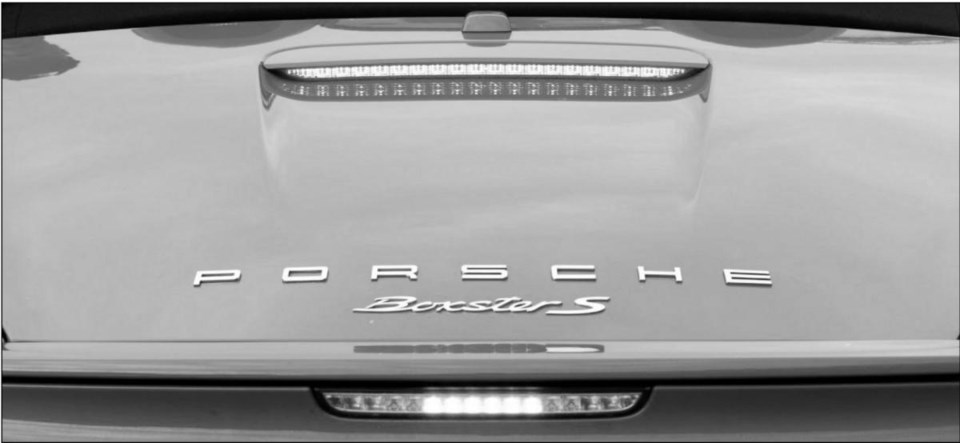If you're one of those drivers who like to hear a performance engine sing while being pushed back in your seat, the 2013 Porsche Boxster S is your car. With a 7,800-r.p.m. redline, the engine in the newest Boxster S is surely music to the ears of performance-car enthusiasts.
Porsche conservatively claims the 315-horsepower car will complete a 0-100 kilometre-per-hour sprint in 5.1 seconds. If you had a racetrack long enough, the S could take you up to its top speed of 279 km/h.
The 3.4-litre flat-six engine, located directly behind the driver and passenger, has been slightly tweaked from last year, gaining five hp in the process. This year, the engine benefits from the addition of variable intake, which makes low-end power delivery just a titch smoother.
But the biggest difference, for me, comes from exhaust modifications. While the Boxster was almost as fast last year, it never sounded muscular. It really only came to life with the addition of a $3,000 exhaust option.
Not this year. The exhaust has a low rumble at times, a bark at others and a deep growl when the right foot is planted deep in the Porsche's carpet. It's like the best within has been unleashed.
The gearing of the six-speed manual transmission is eye-opening. The redline for first gear is around 79 km/h, while second takes you to about 130 km/h. That makes the other four gears good as overdrives.
With 315 hp and 266 lb.-ft. of torque on hand and only 1,320 kilograms to push, the Boxster S is a very satisfying sports car on the highway. And with its mid-engine design, and sticky 19-inch rubber on wide wheels, there isn't any corner that it can't handle. The 2013 also boasts a lighter body and lower centre of gravity.
Throw in Porsche's Torque Vectoring, a variable torque distribution system with a differential lock and automatic braking of the inside wheels in a turn, and you have the ultimate canyon-carving machine.
Some of the exhilaration can be attributed to dynamic engine mounts. Sensors on the engine mounts adapt to changes in driving style and road-surface conditions by stiffening or softening the connection between the engine and the body.
Pressing the Sports Plus button on the centre console not only changes the mapping for the engine, it stiffens the whole drivetrain, giving the S what Porsche calls "race-circuit-like driving."
Surprisingly, even when set at a level that's considered kidney-busting in other cars, the Boxster is still supple and smooth in the city - very impressive.
Like the rest of the car, the cabin has been revised. The biggest piece of equipment missing is the mechanical handbrake - something that's been criticized in the Porsche Carrera as well. A hill-holder and electric switch remain in its place.
The small cubbyhole that spanned the length of the car behind the occupants is sadly gone, leaving nowhere to stash small items in the cosy cockpit.
The instrumentation is about the same, with three deep binnacles directly ahead. The speedometer is on the left and the tachometer is dead ahead, while the third is a multi-function screen that can display information ranging from fluid levels and tire pressure to g-force recorder.
Our tester had the optional Sport Chrono Package, with a jewel-like chronometer at the top of the dash - a nice, classy, yet functional touch.
Unlike some of its competitors, the Boxster still uses a soft top. This keeps the weight as well as the centre of gravity down. It is well-insulated, as I discovered while travelling in driving rain.
The power top can come down quickly when the sun makes an appearance. The air management is impressive. The cabin is almost draft-free, even at highway speeds (with the side windows up). There are mesh screens behind the individual roll-over bars and between the seats.
My biggest complaint about the design is the cupholder placement. Many Porsches have cupholders that slide out from the dash, a practical solution to the lack of real-estate on the centre console.
This time, Porsche has moved the cupholder closer to the driver. That's the good news. Unfortunately, the flimsy contraption now hangs over the centre console. A previous journalist must have spilled some coffee, which landed on the climate-control switches and dried, gumming up the controls. Eventually, they were freed, but it drove home the consequence of poor placement of the holder.
I can just see the letters: You shouldn't be drinking coffee and driving a Porsche.
The 2013 model marks the first major redesign since the Boxster was introduced in 1997. Much has changed in the automotive landscape in the last 15 years. Thankfully, the timelessness of the Boxster's design and its continued refinement contribute to its reputation as the benchmark in its class.
The 2013 redesign should carry the Boxster for another decade.
Perhaps in that time Porsche can relocate that pesky cupholder. In the meantime, just exercise your right foot and listen to the engine sing.
THE SPEC SHEET
Engine: 3.4-litre horizontally-opposed six-cylinder, 315 hp at 6,700 r.p.m., 266 lb.-ft. of torque at 4,500 to 5,800 r.p.m.
Transmission: Six-speed standard
Dimensions (mm): Length, 4,374; width, 1,801; height, 1,281; wheelbase, 2,475
Curb weight (kg): 1,320
Price (base/as tested): $69,500/$86,705 (includes $1,085 destination and $100 AC tax)
Options: Infotainment package, $4,410, Premium package $4,290, Torque Vectoring $1,510, Porsche Active Suspension Management $2,050, Sport Chrono Package $2,110, SportDesign steering wheel $290, platinum-paint wheels $970, red seat belts $390
Tires: 235/40 ZR19 front 265/40 ZR19 rear
Fuel economy (L/100km): 10.5 city/ 7.2 highway
Warranty: Four years/80,000 km new car with roadside



